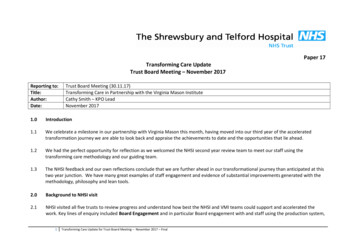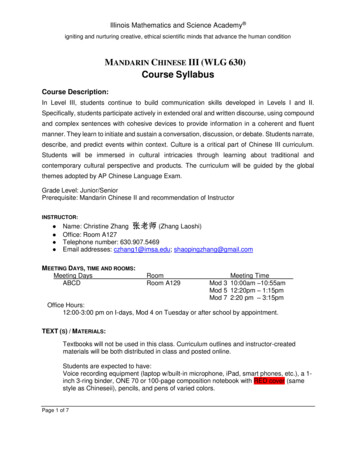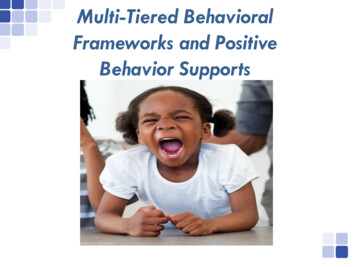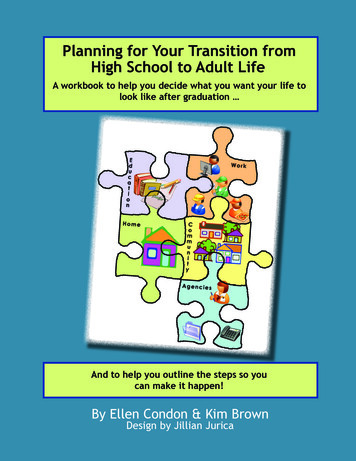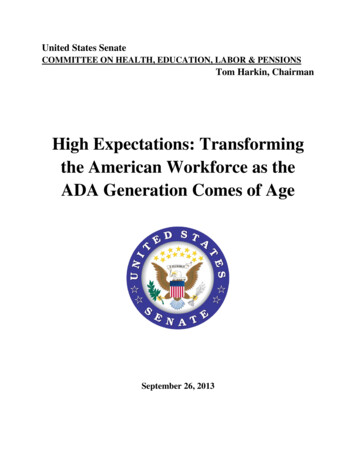
Transcription
United States SenateCOMMITTEE ON HEALTH, EDUCATION, LABOR & PENSIONSTom Harkin, ChairmanHigh Expectations: Transformingthe American Workforce as theADA Generation Comes of AgeSeptember 26, 2013
ContentsOPEN LETTER FROM CHAIRMAN HARKIN . 2THE ADA GENERATION . 10FOUR AREAS OF OPPORTUNITY . 15OPPORTUNITY ONE: HIGH SCHOOL. 16OPPORTUNITY TWO: TRANSITION . 19OPPORTUNITY THREE: LONG TERM SUPPORT PROGRAMS . 23OPPORTUNITY FOUR: WORKPLACE SUPPORTS . 26EMPLOYMENT AND THE ADA GENERATION . 30A GOAL AND RECOMMENDATIONS . 31High Expectations: Transforming the AmericanWorkforce as the ADA Generation Comes of Age1Senate Committee on Health, Education,Labor, and Pensions
OPEN LETTER FROM CHAIRMAN HARKINIn July 2012, I released a report titled “Unfinished Business: MakingEmployment of People with Disabilities a National Priority.” In it, Idescribed the ongoing crisis of persistently low labor force participationrates of people with disabilities, and outlined what I see as some historicopportunities to improve this situation. My greatest source of optimismabout growing the disability labor force comes from the generation ofpeople with disabilities who have come of age after the passage of theAmerican with Disabilities Act (ADA). These youth and young adults,or the “ADA Generation” as I call them, have attained unprecedented education levels ininclusive settings and have an expectation to be included as valued members of the Americanworkforce. As Chairman of the U.S. Senate Committee on Health, Education, Labor andPensions (HELP Committee), I am concerned that America is failing to fully leverage the talentsof this generation and the investment we have made in these young people. Let’s not waste thishistoric opportunity to welcome these talented and motivated youth and young adults into thecompetitive labor force.Building on “Unfinished Business,” this report examines the lives of the young people who makeup the ADA Generation. This report shares their firsthand experiences in education, withdisability benefit programs, with transition programs, and in the workforce. The most recent dataavailable describing the education and employment situation for youth and young adults withdisabilities are presented. Fueled with the optimism of these young people, I renew my call forthe leadership in Congress, the Administration, and the business community to prioritize theemployment of people with disabilities, including the members of these young people withdisabilities. And, to this call, I add a series of recommendations for bipartisan reforms intendedto improve the programs that support the ADA Generation as they pursue their employmentgoals.There has been great progress since the signing of the ADA more than twenty-three years ago.The ADA (passed in 1990), along with the Individuals with Disabilities Education Act (IDEA)High Expectations: Transforming the AmericanWorkforce as the ADA Generation Comes of Age2Senate Committee on Health, Education,Labor, and Pensions
(passed in 1975), ushered in a series of changes in American society designed to enhanceaccessibility and opportunity for children and adults with disabilities who, for far too long, hadbeen excluded from community life. Unlike previous generations, today’s youth and youngadults have grown up with public transportation systems that have elevators and lifts; sidewalksthat include curb ramps; and sports arenas, concert venues, museums, and movie theaters thathave accessible seating and provide information and entertainment in a variety of accessibleformats. Approximately 13 percent of all public school students receive education services underIDEA, and between 1996 and 2005 the percentage of students with disabilities exiting schoolwith a standard high school diploma increased from 43 to 57 percent. i iiWe have made tremendous investments in the members of the ADA Generation and they areprepared to embrace bright futures. However, despite the wonderful progress in physical andcommunication accessibility, and in the access to education these laws enabled, there is still agreat deal of work to be done to fully realize the equality of opportunity promised by the ADA.The sad reality is that more than two-thirds of Americans with disabilities are not in the labormarket, and disability employment has not increased since 1990. As of August 2013, there was agap between the labor force participation rate of young adults age 25 to 34 with disabilities andtheir non-disabled peers that exceeded 40 percent. This employment gap persists across all ages,from teenagers to 35 year olds, and the disparities are particularly large for racial and ethnicminorities with disabilities. There are also significant disparities in the labor force participationrates for young veterans who became disabled as a result of their military service.However, there is one bright spot. There is a relatively small gap in the labor force participationrates of individuals with disabilities and their peers in the 16 to 19 year old age range. This lightin an otherwise dark room presents an important opportunity. Whereas the employment rate for25 to 34 year olds with disabilities has been only half that of their peers, the gap in the laborforce participation rate for 16 to 19 year olds with disabilities and without disabilities has beenon average only ten to 15 percent. If we can ensure youth in this age group are hired at the samerate as their peers, and provide them with the support they need to remain successful in theworkplace, we can make tremendous progress toward providing equal opportunity to all.High Expectations: Transforming the AmericanWorkforce as the ADA Generation Comes of Age3Senate Committee on Health, Education,Labor, and Pensions
In this report, I identify four key areas of opportunity to improve our support for members of theADA Generation as they seek competitive employment. These areas are: Increasing support for high school students as they plan for their transition into theworkforce; Improving the transition of the ADA Generation as they enter postsecondary educationand the labor market; Changing the assumptions in disability benefit programs that discourage young peoplewith disabilities from working; and Leveraging employer demand, correcting misconceptions about employing people withdisabilities, building strong pipelines from school to the competitive workforce, andestablishing supportive workplaces.Opportunity One: High School: Improving transition planning and activities from high schoolis essential to increasing disability employment. While most high school students receive sometransition planning as required by the IDEA, this planning could be significantly improved byensuring the participation of all relevant school staff, along with out-of-school partners such asState Departments of Developmental Disability, Departments for the Blind and VisuallyImpaired, and Social Security Agencies, and securing support from state Departments ofVocational Rehabilitation, all as early as possible in the transition planning process. As part oftheir transition, students should have access to early work experiences and internships, which arehighly correlated with positive employment outcomes after high school. Transition planningneeds to occur earlier in students’ high school careers to ensure they have the opportunities totake full advantage of the services and supports they need. That is why I support decreasing theage at which the IDEA requires schools to begin planning for student transitions from 16 years ofage to 14 years of age. This is also why Senator Alexander and I included, in the WorkforceInvestment Act reauthorization recently approved by the HELP Committee, a requirement thatstate vocational rehabilitation agencies spend at least 15 percent of their vocational rehabilitationfunds providing services to youth in transition, including pre-employment transition services toyouth in high schools.High Expectations: Transforming the AmericanWorkforce as the ADA Generation Comes of Age4Senate Committee on Health, Education,Labor, and Pensions
Opportunity Two: Transitions: We know that higher education is a critical factor in attainingemployment, particularly for youth with disabilities. However, only 15 percent of high schoolgraduates with disabilities attend a four year college. If we can link our talented young people toappropriate postsecondary opportunities, including certificate programs, career and technicaltraining opportunities, community colleges, and two and four year degree programs, they willenter the labor market more attractive to employers and more prepared to succeed. We shouldalso learn from states like Washington that have successfully adopted “Employment First”policies. These state plans expect that all youth with disabilities are able to work in thecompetitive, integrated workforce, including those with the most significant disabilities. Afteradopting Employment First as a state policy, King County in Washington increased thepercentage of youth with intellectual and developmental disabilities transitioning to competitiveemployment from six percent to 56 percent in just five years. iiiOpportunity Three: Changing the Incentives of Disability Benefit Programs: Two programs– Social Security Disability Insurance and Supplemental Security Income – and their linkages topersonal care supports through Medicaid, and Medicare, play significant roles in providingsupports and services to Americans with disabilities. For many of the youth of the ADAGeneration, tapping these supports comes with a great cost. While the Affordable Care Act willprovide many young people with disabilities health care coverage, particularly through theopportunity to purchase coverage through the state exchanges, that coverage may not include thepersonal care supports that states provide through their Medicaid Community and Home BasedWaiver programs. In order to receive such services and benefits, young people with disabilitiesare often forced to commit to, at an impossibly early age, a lifetime in poverty without work.SSI and SSDI rely on an outdated definition of disability that assumes those with disabilitiescannot work, and makes the eligibility for support services contingent upon young peopleproving with medical evidence that they cannot and will not be able to work and earn enough tosupport themselves. Specifically, a young person must claim they will not be able to “engage insubstantial gainful activity,” to quote the language from 1956 in the Social Security Act. Thisrequirement creates disincentives for young people with disabilities who are compelled to choosebetween forgoing benefits and launching a career, or forgoing work in order to receive benefitsand attend to their daily support and healthcare needs. We need to modernize these programs soHigh Expectations: Transforming the AmericanWorkforce as the ADA Generation Comes of Age5Senate Committee on Health, Education,Labor, and Pensions
that federal policy is to encourage, not discourage, work. This is a problem for all working-ageadults with significant disabilities, but it is particularly egregious for young people who have alifetime of work, and a lifetime of opportunities, ahead of them.Opportunity Four: Workplace Supports: In order to increase the labor participation rate forthe ADA Generation, we must overcome barriers preventing the business community from hiringpeople with disabilities. At the same time the business community is looking for skilledemployees, we are graduating members of the ADA Generation who have had more access toand more success in education than any previous generation. We need to build pipelines andfacilitate matches between employers and young people, coordinate state VocationalRehabilitation services with pre-kindergarten through 12th grade and post-secondary educationprograms to create a national pipeline of talent, and ensure that supported employment servicesremain in place for the duration of an employee’s career.The new final rule enforcing Section 503 of the Rehabilitation Act, which requires federalcontractors to engage in affirmative efforts to identify, recruit, promote and retain qualifiedworkers with disabilities, creates a unique opportunity to increase employer demand in a sectorthat employs more than 20 percent of the American labor force. My hope and expectation is thatthe Department of Labor will work with the Departments of Education, Health and HumanServices and others to help build pipelines that will connect young people with disabilities withfederal contractors who are hoping to hire them.We must also correct misconceptions that hold employers back from hiring young people withdisabilities. Research shows that employers overestimate the costs of providing workplaceaccommodations, underestimate the productivity of workers with a disability, and hold lowexpectations for the workplace performance of members of the ADA Generation. In reality,approximately 80 percent of workplace accommodations cost less than 1,000. iv Studies showthat hiring employees with disabilities can increase business productivity and decreaseabsenteeism. Finally, young people with disabilities often thrive in competitive environmentsand leadership positions, providing employers with additional, valued employees.High Expectations: Transforming the AmericanWorkforce as the ADA Generation Comes of Age6Senate Committee on Health, Education,Labor, and Pensions
ADA Generation Goals and RecommendationsIn April of 2011, the US Chamber of Commerce and I established a goal of increasing theworkforce participation of people with disabilities by more than 20 percent, from 4.9 millionworkers to six million workers by 2015. In August 2013, young adults ages 16 to 35compromised approximately six percent of the 4.9 million individuals with disabilities in theworkforce. Based on these numbers, I believe we should set a goal of increasing the workforceparticipation of young adults with disabilities by 250,000 new workers by 2015.To accomplish this goal, we must provide members of the ADA Generation with opportunitiessuch as quality internships, part-time jobs, and other work experiences while they are still inschool. One of the critical strategies to reach this goal is to require State VocationalRehabilitation agencies, schools, Medicaid providers, and other key partners to work with youngpeople with disabilities, starting at age 14, to identify and develop labor force skills. Thisincludes having access to: Work-based learning experiences including internships, summer employment, andcompetitive, paid employment in integrated settings; Intensive transition planning, which includes the student’s family, to determine whatpost-secondary education and training is needed to meet their independent living,employment, health care, and other support needs; Benefits counseling that informs youth of the availability of waivers and work incentivesthat will enable them to retain benefits and be healthy and independent as they begin toseek full-time work opportunities in the labor force.We must do a better job at enrolling youth in Vocational Rehabilitation services early in theirhigh school careers, and ensure that our young people are presented with a variety ofpostsecondary opportunities that will help them develop critical skills. We should create acoordinated pipeline to match our talented young people, in whom we have invested so much,with employers. We should modernize our government programs so that people with disabilitiescan enter the workplace, contribute to their communities, and invest in their futures withoutputting their essential benefits and supports at risk. And we should ensure that states seeHigh Expectations: Transforming the AmericanWorkforce as the ADA Generation Comes of Age7Senate Committee on Health, Education,Labor, and Pensions
competitive, integrated employment as the first option for all our young people, no matter howsevere their disability.In the Chairman’s role, in the coming months, I will work on a bipartisan basis with the membersof the Committee to explore ways to increase the flexibility that our federal and state agencieshave to meet the above goals. We need to create a combination of policies, incentives andflexibility that will promote partnerships among states and businesses to increase earlyconnections to work for young people with disabilities and implement the intensive planningneeded for youth to have successful, live-long careers.To create both the opportunities and the incentives for young people to work, I am setting anaggressive legislative agenda. I will work to pass the reauthorization of the S. 1356, theWorkforce Investment Act of 2013, which was approved by the HELP Committee in July with abipartisan vote of 18-3. S. 1356 would require state and federal vocational rehabilitation partnersto ensure that young people with disabilities have access to quality pre-employment transitionservices, and access to good jobs and post-secondary opportunities when they leave high school.I will introduce a bill to ensure that youth transitioning from Section 504 and special educationservices will have full access to pre-employment training and supports. And we need to addressthe issue of allowing young people with disabilities to accrue capital, just as all other youth areable to do so. One way to do this is by amending the restrictions on savings for those who areeligible for the SSI and SSDI programs. Legislation such as S. 313, the Achieving a Better LifeExperience Act, or ABLE Act, which will create tax-free savings accounts so that members ofthe ADA Generation can invest in their futures without losing critical benefits, is one way toaddress this issue. Finally, I will work with my colleagues on the HELP Committee to introducethe Entrepreneurs with Disabilities Act, which will make it easier for business owners to besuccessful in the marketplace.By shining a spotlight on the barriers to participating in the labor force for the current generationof youth and young adults with disabilities, and moving beyond the data to share some personalstories, this report is intended to draw attention to and prompt action in support of the individualemployment goals these young adults are working hard to achieve. I encourage leaders from thepublic and private sectors to join with me in taking steps to ensure that the goals of the ADA areHigh Expectations: Transforming the AmericanWorkforce as the ADA Generation Comes of Age8Senate Committee on Health, Education,Labor, and Pensions
within grasp of our nation’s youth and young adults with disabilities. These four goals – 1)equality of opportunity; 2) full participation; 3) independent living; and 4) economic selfsufficiency – are the birthright of this generation and we must work together to ensure thispromise is met.Tom Harkin, ChairmanSenate Committee on Health, Education, Labor and PensionsHigh Expectations: Transforming the AmericanWorkforce as the ADA Generation Comes of Age9Senate Committee on Health, Education,Labor, and Pensions
THE ADA GENERATIONThe youth and young adults of “the ADA Generation” came of age after Congress passed theAmericans with Disabilities Act (ADA) in 1990. The young people with disabilities who makeup the ADA Generation have benefitted greatly from the letter and spirit of that historic civilrights law. Compared to prior generations, the members of the ADA Generation have increasedaccess to education, public venues and transportation, workplace accommodations, andtelecommunications.While older generations of Americans with disabilities were often excluded from communitylife, the ADA Generation is able to navigate through their communities with greater ease thanever before. Young adults with disabilities have grown up with public transportation systemsthat often have built-in accessibility features; sidewalks that include curb ramps; and sportsarenas, concert venues, museums, and movie theaters that have accessible seating and provideinformation and entertainment in a variety of formats. Members of the ADA Generation haveseized the opportunity to fully participate in their communities and experience the sameenriching opportunities as their non-disabled peers.The members of the ADA Generation have also grown up with unparalleled opportunity toaccess education in inclusive settings. The passage of the Education for All HandicappedChildren (now known as the Individuals with Disabilities Education Act, or IDEA) in 1975ensured that youth with disabilities attend schools that emphasize inclusion and have highexpectations for all students’ education and employment outcomes. The IDEA provides youthwith disabilities a tailored program, the Individualized Education Program (IEP), which spellsout the learning accommodations and supports they need to be successful in school. In 2011,about 13 percent of public school students, or 6.5 million total, received education services underIDEA, and about 72 percent of students with disabilities earned credits in general educationclassrooms. vThe positive impact of this individualized focus can be seen in the recent data on theperformance of youth with disabilities in public schools. Between 1997 and 2006, the number ofHigh Expectations: Transforming the AmericanWorkforce as the ADA Generation Comes of Age10Senate Committee on Health, Education,Labor, and Pensions
students with disabilities leaving high school with a standard diploma increased from 43 to 57percent. vi Members of the ADA Generation are also obtaining undergraduate and graduatedegrees at higher rates than students with disabilities who came before them. viiPerhaps most importantly, there has been a substantial change in attitudes. More and moreAmericans now see accessibility and accommodations as essential elements of an inclusivesociety, and not “special treatment” for a narrow population. The ADA Generation has grownup in an America that promises them full participation, equal opportunity, independent living,and economic self-sufficiency, and they have high expectations for themselves. They have thesame hopes and dreams as other young Americans: to live independently, find competitiveintegrated employment that speaks to their motivations and interests, join the middle class, andcontribute their considerable talents and skills to their communities.The ADA Generation in the workforceThe members of the ADA Generation know that being employed is part of being an adult in oursociety. These young adults are eager to work, but more than two-thirds of Americans withdisabilities are not in the labor market. In fact, despite the increased access and opportunityunder the ADA, employment outcomes for people with disabilities have not improved since1990. The progress in disability employment is stagnant even though research shows that whenadults with disabilities are integrated into an inclusive workforce, employers suffer no loss inproductivity and employee retention rates increase. viii Higher rates of employment are beneficialto those with disabilities and their communities. Higher workforce participation is associatedwith lower incidences of crime, a greater sense of community, and an increased sense ofcollective responsibility. ixOur young people with disabilities are entering the workforce at a time when employment ratesare declining precipitously for all youth. x Approximately 2.2 million teenagers and 4.3 millionyouth ages 20 to 24 are neither in school or working. Even in these historically stark times foryouth employment, the situation is dramatically worse for youth with disabilities. In June of2013, there was a 40.8 percent gap between the employment rate of young adults age 25 to 34with disabilities and their non-disabled peers. xiHigh Expectations: Transforming the AmericanWorkforce as the ADA Generation Comes of Age11Senate Committee on Health, Education,Labor, and Pensions
Table 1: Labor Force Participation Rates by Age and Disability, 16-19 Year Olds, June2008-June 20135047.64542.140353037.729.625201516-19 Years Oldwith a Disability10Jun- Mar Dec Sep- Jun- Dec Mar Sep- Jun- Mar Dec Sep- Jun- Mar Dec Sep- Jun- Mar Dec Sep- 0Jun- 5Table 2: Labor Force Participation Rates by Age and Disability, 20-24 Year Olds, June2008-June 201390.080.075.170.060.048.250.046.140.030.020-24 Years Oldwith a Disability20.0High Expectations: Transforming the AmericanWorkforce as the ADA Generation Comes of Age12Jun- Mar Dec Sep- Jun- Mar Dec Sep- Jun- Dec Mar Sep- Jun- Mar Dec Sep- Jun- Mar Dec Sep- 0.0Jun- 10.0Senate Committee on Health, Education,Labor, and Pensions
Table 3: Labor Force Participation Rates by Age and Disability, 25-34 Year Olds, June2008-June 0.025-34 Years Oldwith a 2Jun-13The gap persists across all age groups, from teenagers to 35 year olds. The largest gaps areamong individuals age 25 to 34. For the past five years, the labor participation rate of youngpeople with disabilities in this age range has been only half that of their non-disabled peers. xiiOn the other hand, the gap in the labor force participation rate between young people age 16 to19 with a disability and without a disability has been, on average, only about ten to 15 points. xiiiAt this transitional time in a young person’s development, we must encourage full participationin the daily activities of society. Establishing the norms and providing the opportunities forsuccessful, live-long engagement in work will result in more positive outcomes for youngpeople, as well as for everyone in their communities. By closing the gap in workforceparticipation between those young people with and without disabilities, we will increase thelikelihood young people will be more self-sufficient and independent throughout their adultlives.High Expectations: Transforming the AmericanWorkforce as the ADA Generation Comes of Age13Senate Committee on Health, Education,Labor, and Pensions
Table 4: Labor Force Participation Rates by Race and Disability, 25-34 Year Olds, June2013Labor Force Participation Rates by Race and Disability, 25-34 years ofage (BLS: June 2013)44.2Hispanic or Latino with a DisabilityHispanic or Latino, no Disability79.9Asian with a Disability65.879.1Asian, no Disability36.6Black with a Disability81.1Black, no DisabilityWhite with a Disability42.784White, no Disability0102030405060708090The disparities are particularly large for racial and ethnic minorities with disabilities. In June of2013, there was a 35.7 percent gap between Hispanic and Latino individuals age 25 to 34 withdisabilities and their non-disabled peers, a 13.4 percent gap between Asian disabled and nondisabled individuals, and a 44.5 percent gap between Black disabled and non-disabledindividualsTable 5: Labor Force Participation Rates by Race and Gulf War Veterans Status, March2013Labor Force Participation Rates by Disability and GulfWar II Veteran Status (BLS: March 2013)44.0%Veterans, Gulf War II, with a Disability82.8%Veterans, Gulf War II, no disability0%10% 20% 30% 40% 50% 60% 70% 80% 90%High Expectations: Transforming the AmericanWorkforce as the ADA Generation Comes of Age14Senate Committee on Health, Education,Labor, and Pensions
There are also disparities in labor force participation rates for veterans who became disabled as aresult of their time in military service. In March of 2013, more than 80 percent of non-disabledrecent veterans were employed or looking for work, compared to less than 45 percent of veteranswith a disability. xivFOUR AREAS OF OPPORTUNITYThe relatively small gap in labor force participation rates between individuals with disabilitiesand their peers in the 16 to 19 age range presents an opportunity to address a major barrier toequality for young people with disabilities. If we can ensure our young high school studentswith disabilities are hired at the same rate as their nondisabled peers, and provide them with theassistive technology, support, and training they need to remain successful in the workplace, wewill make tremendous progress towards providing equal economic opportunity for all. There arefour main areas of opportunity to help students with disabilities successfully join the labor force.We can help our young people find jobs and work towards economic independence by: Increasing support for high school students as they plan for their transition into theworkforce; Improving the transition of the ADA Generation as they enter postsecondary educationand the labor market; Changing the assumptions in disability benefit programs that discourage young peoplewith disabilities from working; and Leveraging employer demand, correcting misconceptions about employees withdisabilities, and establishing supportive workplaces.If we can take advantage of these tremendous opportunities, our young Americans withdisabilities will rise to the occasion and successfully transition into the workforce at the samerate as their non-disabled peers.High Expect
the ADA Generation, we must overcome barriers preventing the business community from hiring people with disabilities. At the same time the business community is looking for skilled employees, we are graduating members of the ADA Generation who have had more access to and more success in education than any previous generation.





